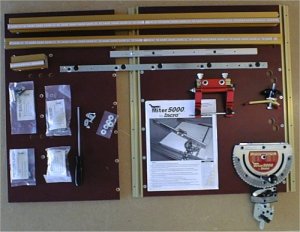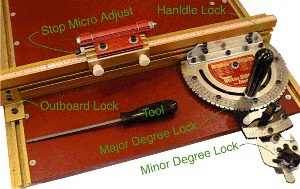|
|
|
Function |
 |
| Impressions My first impression of this accessory even before it was assembled is something akin to "I wish the rest of my saw were made with this attention to detail, quality, and precision". Part of the normal process of assembling and tuning woodworking machines and most accessories for me involves quite a bit of deburring of edges, lubrication, chasing tapped holes and whatnot. The Incra is a noticeable step above all this as I basically didn't have to do any of these things. |
|
 |
Assembly There isn't a lot of assembly involved with the 5000; it will take about as long to assemble as it will to remove all the parts from its packaging. There is a well written manual that explains in detail how to assemble and align the unit. Allen wrenches used to assemble and align the 5000 are included in the package as well. The only tool the owner needs to supply is a Phillips screwdriver. |
| The 5000 ships in a single large 40lb box.
Inside is a marvel of packaging design wherein there is not one cubic inch of wasted
space. All the individual components are packaged separately, this include the
various fasteners in their own group of marked bags for each sub assembly. There
were no damaged or missing parts in my package. There will be a few unused pieces of
hardware when the unit is completely assembled. In the view at the top of the page the right sub-base is shown un-cut. When the 5000 is used this sub-base is cut which provides in effect a zero clearance insert effect for the blade which reduces tearout. The section to the right of the blade also has a runner attached to its bottom but it remains stationary on the saw. There are three sets of attachment holes for the right sub-base runner which should fit most saws. If not, the sub-base can still be used although it may require drilling your own holes. |
|
| Accuracy Once I had installed the 5000 on a saw and fit the miter gauge bar to its slot I noticed that the fence could still move a bit so I decided to do a simple measurement test. When the outboard lock on the fence was not used (basically in Miter3000 mode) it is possible for the fence to move. The amount varies according to the force applied so for a test I picked a force that would represent a small unintentional "bump" from an operator that could occur in a normal shop environment. Although the fence visibly moves with the force I used, the actual accuracy is STILL good, measured at +/- 0.06 degrees. I also measured the repeatability to be within 0.05 degrees when the outboard lock is not used. Assuming the miter gauge bar is adjusted properly and the outboard lock is tightened down there is absolutely zero movement. I measured the repeatability accuracy when using the outboard lock to be within 0.04 degrees. Ultimately, the device is as accurate and repeatability as one would ever need to be in woodworking. It is significantly better than the OEM miter gauges supplied with common saws which don't even include a crosscut fence of any kind! Once aligned, this will allow even a casual user to be spot-on accurate with any miter angle. The stock clamp contributes to this accuracy as well since it prevents stock movement during cuts. The fence itself measured straight against my machinists straight edge. I've previously measured the Incra rack positioning repeatability to be +/- 0.002", most of the time it is far better than even that though. |
Operation The view at right shows most of the controls for setting angles on the 5000. The tool shown along with two other Allen wrenches are supplied with the unit. The tool shown is used to assemble and operate the 5000 since there are several Allen bolts used on the device; the other two wrenches are used in alignment only. |
 |
| To change from one angle to another requires the operator to twist the handle to loosen it, unlock the Major Degree Lock, and loosen both the Allen bolts of the outboard lock. The fence can then be moved to the new angle. If the new angle is one of the commonly used ones it will lie on the major degree scale. If not the Minor Degree Lock can be undone to put the fence to any angle in 1/2 degree increments. Once the desired angle is set, the four or five locks are re-engaged. | |
|
This is a close up view of the flip stop.
The stop is positioned using the 1/32" racks Incra is famous for. I've measured
these racks to be repeatable within +/- 0.002", most of the time they are RIGHT on
though. The beauty isn't that these racks provide such incredible accuracy.
The beauty is that it transforms positioning into the "digital realm".
This allows a user to easily and repeatable make cutoffs "by the numbers".
No more cutting to a line or mark, just set the stop to the desired numerical dimension
and it will BE that length. To move the stop, the two big nylon knobs on the back must be loosened. The stop is then slid to the new position and the knobs are re-tightened. The position is read by sighting down the edge of the stop assembly. If some other position that does not fall on an increment of 1/32" is desired, the stop can be micro adjusted by loosening the two Allen bolts on top and moved using another Allen screw to drive the stop to a new location. |
| Unlike many stops I've used, this one does not
suffer from the flip action loosening the bearing thereby creating slop. Once the
desired level of flip-friction is set, it stays that way. The crosscut fence itself has several small grooves in its face. There are mating grooves in the flip stop arms. With the stop flipped down, these grooves act as extensions into the fence. This allows the operator to place a mitered (sharp) end of a piece of stock against the stop without fear that the sharp end will move the stop itself thereby throwing off the cut. |
|
In the interest of full disclosure, Incra provided this product to facilitate this review.
|